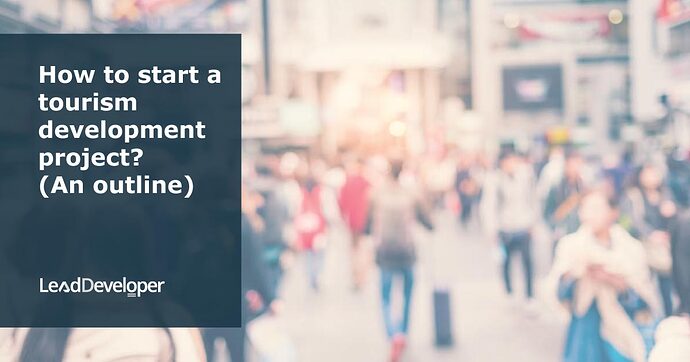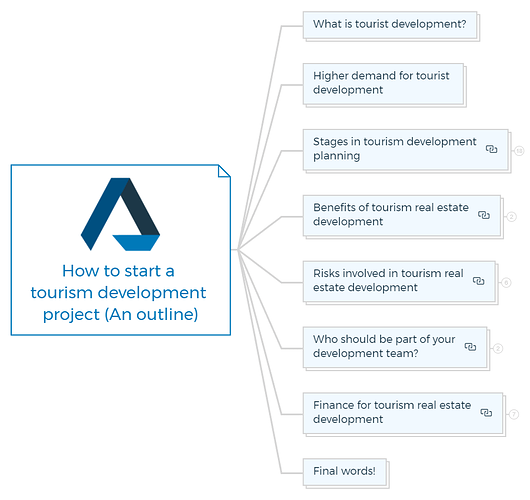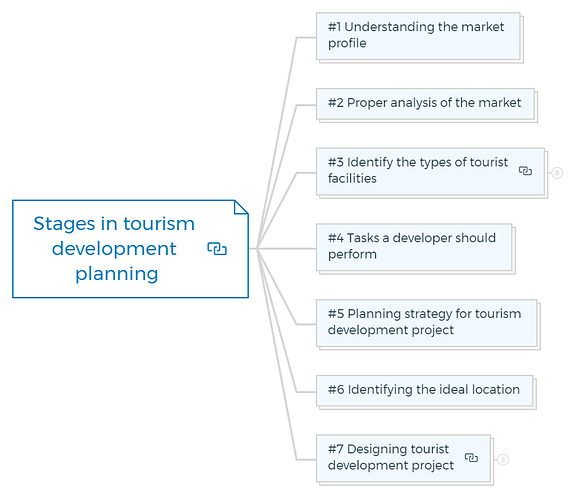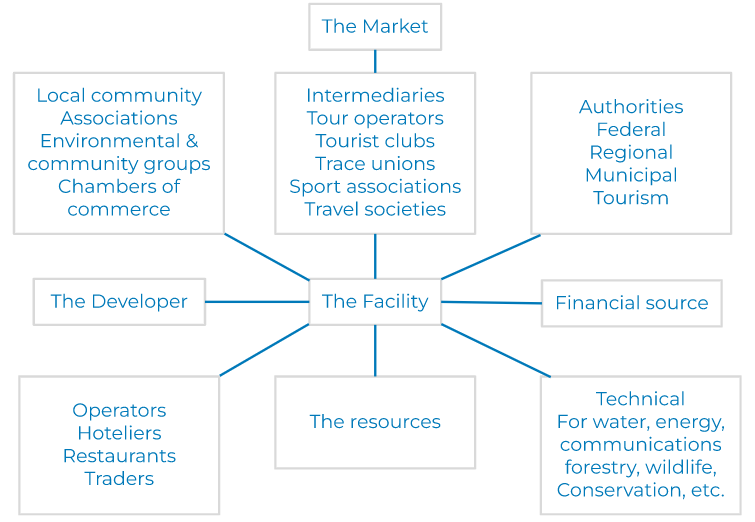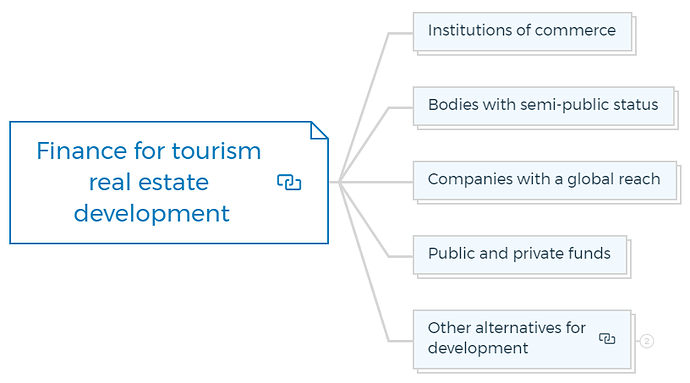Developer’s guide to tourist development projects - Types, demand, & strategy
The tourism industry has grown significantly in recent years, and this trend shows no signs of slowing down anytime soon. As the number of tourists visiting particular areas increases, real estate developers naturally want to seize the opportunity to capitalise on this demand and bring in additional revenue and jobs from their local communities.
To properly execute tourism development projects, developers need to understand the basics of tourist development first. This article will walk you through the types of tourist developments facilities and outline typical demands and strategies required for such projects.
What is tourist development?
Tourist development and planning can mean different things to different people, but in general terms, it is about creating strategies and plans to increase/develop/encourage tourism for a destination.
The fundamental objective for designing and implementing tourist development strategies is to produce money and, as a result, raise a country’s or region’s GDP.
This form of property development is complex since it is subject to the influence of numerous parties, each with an opinion on the outcome. These parties include -
- Both federal and state government
- City planners
- Tour Operators
- Environmentalists
- Lobbying firms
- Associations working in the field
- The public
Many contributors will have strong opinions about what tourism should be like and a financial stake in the outcome. The developer’s job is to bring all parties together to achieve a common goal.
You are missing out if you haven’t yet subscribed to our YouTube channel.
Higher demand for tourist development
Many government reports at the world, national, and municipal levels focus on tourism and, to a lesser extent, leisure and recreation. Many newspaper stories and journals have detailed its growth, organisation, and impact on the economy and environment.
Tourism has long been an essential economic factor in many countries, but countries now recognise it as a significant contributor to the overall economy.
Australia, for example, has seen a significant increase in international tourism in the past few years, necessitating higher standards of facilities and services to meet this demand.
Several other countries are experiencing similar growth in this industry, such as Canada, the United States, the United Kingdom, etc.
Here is the property development checklist you can rely on for any of your projects.
You are missing out if you haven’t yet subscribed to our YouTube channel.
Stages in tourism development planning
#1 Understanding the market profile
It is vital to understand the profile of tourists and to distinguish between several tourist categories to plan, in particular:
- Business Tourists: People who travel for business reasons, such as attending conferences, exhibits, or business meetings.
- Leisure Tourists: Tourists who travel for enjoyment or general interest.
- Specific tourists: This category comprises students, athletes, pilgrims, and any other group traveling for a particular reason.
#2 Proper analysis of the market
Market analysis has its own importance. For a variety of reasons, evaluating the tourism industries from a developer’s standpoint is complex, including:
- Leisure is mainly a question of personal preference; there are numerous recreational activities to select.
- The average person does not have enough time to engage in recreational development activities.
- Age, marital status, income, and educational background are all personal factors that make it challenging to create a property that appeals to everyone.
- It can be challenging to find appropriate resources and create facilities to use them properly.
- Traveling to and from locations might take a long time and cover a considerable distance.
- There may be little or no public transportation available.
It would be best to research the demand under two headings for planning purposes: effective current demand and latent demand.
You can use the following methods to get this information:
- Use the data of the State Bureau of Statistics and other bureaus and tourist organisations to estimate effective current demand.
- Latent demand is more difficult to quantify, and projections depend on a smattering of indexes and statistics, which are often only approximate.
In addition, you should also evaluate the development location to the frequency of use in the following categories:
- One-day trips to the outskirts of cities or deeper into rural places that are easily accessible from cities.
- Weekend and short vacations that one can spend in a vacation house or regular weekend lodging near to the city or urban centre.
- Extended vacations might be spent sightseeing or sojourn in the nation or abroad.
#3 Identify the types of tourist facilities
The tourist facilities fall into two major categories:
- Manufactured facilities: include accommodations, restaurants, eateries, entertainment, leisure, and relaxation components common to all types of resorts or destinations.
- Natural facilities include features of a particular locality used for recreation, for example, seaside, mountains, rivers, lagoons, and natural reserves.
Accommodation
The following are the many types of resort lodging:
- Hotels: these offer room accommodations, refreshments and meals at sporadic intervals. In some situations, hotels cater to and accommodate specific tour groups or cater to locals.
- Motels: These are strategically positioned hotels to provide lodging for motorists. They don’t offer meals if nearby restaurants or self-catering facilities are available in most circumstances.
- Guesthouses: Boarding houses are smaller units that provide lodging and meals to visitors who want to remain for an extended period.
- Hostels: places where specific groups of people, such as youth organisations and sports teams, can stay. Facilities are often shared, and accommodations are simple.
- Caravan sites: camping areas with basic sanitary amenities, water, and, in some cases, power. Restaurants, stores, fuel stations, and outdoor and indoor recreation facilities are also available at some sites.
- Holiday apartments: clusters of units that are typically self-catered and offer higher-quality lodging.
- Holiday villages: groups of individually constructed units around a central catering, usually designed for family and group use. The majority of meals are self-catered. This facility is most common in rural settings, where land is abundant and less expensive.
Casinos
The government closely regulates casinos, and obtaining a license to build and manage this tourist attraction is difficult. Many real estate developers who have succeeded in getting such a licence have amassed enormous money.
Centres for entertainment
Cinemas, restaurants, food halls, flea markets, and small shops are examples of entertainment centers common in a tourist area or a building complex.
Golf courses estates
You will find several successful resorts near a golf course. The recreational connotations and visual appeal of a regulation 18-hole course add to the value of the neighbouring building lots.
Marina developments
Marina and harbour projects that include boating and fishing activities have a romantic appeal. However, given the high investment costs, such a project should only be considered after conducting a regional feasibility assessment and finalising a regional structure plan for tourism and recreation.
Waterfront construction
Waterfronts can be both natural and artificial. Natural lakes and estuaries are always appealing, and economic development plots cost a high price in these areas. Artificial waterfronts are typically built around natural depressions and are more suited for commercial development.
Over the last decade, waterfronts with commercial and tourism attractions have grown in popularity surrounding existing harbours. Two such developments are Darling Harbour in Sydney and Docklands in Melbourne.
Theme Parks
Theme parks are appealing to day-trippers and families. One dominant theme works as the primary attraction, which depends on imagination, nostalgia, escapism, or experiencing the thrills of a jungle or a strange and fantastic experience.
Conferences Halls
Every major city should provide conference facilities to capture this rising market, as large exhibitions and trade events occur regularly worldwide.
#4 Tasks a developer should perform
The property developer has the most say in what kinds of facilities will be built, since they must work within the limits of a changing market and limited resources, as well as consider the needs of many different groups.
The developer can be a private business owner or state, federal, or local government, either on its own or in partnership with a private business. The below shows the role of the developer in relation to the many people who will have a say in what kinds of amenities the development will have.
The role of the property developer in a tourism project
No matter what tasks you are going to perform. These property development courses for property developers and investors will make you ready to get started in property development today.
#5 Planning strategy for tourism development project
Various property development and investment strategies are available depending on the project’s size, location, and market. Property developers working on tourism real estate projects should consider the following options:
- For a low price, purchase a large yet well-located lot of land.
- Construct infrastructure and significant attraction facilities such as a harbour or golf course and restaurants and shops to increase the value of this area.
Subdivide and sell vacant lots, individual homes, chalets, apartments, or time-shares for a profit covering all development costs and the developer’s profit.
#6 Identifying the ideal location
Most tourism facilities are affected by the following factors when choosing a development site:
- Look for places with a major attraction or a must-see feature.
- Watch out for temporary attractions or exceptional events like the Olympics or Commonwealth Games. Will your project be financially sustainable when demand for housing declines?
- Examine accessibility by road or air.
- Consider that travelers visiting various points of interest will require public transportation or automobile rental services.
- Complimentary visitor amenities like retail and other commercial activities will always add value to tourist development.
Industry Insiders’ Secrets To Managing Risks & Avoiding Mistakes & Pitfalls In Property Development
Get the Risks & Mistakes Bundle Now
Includes 5 x detailed eBooks [120 pages]
✓ Risks In Property Development - Industry Insiders Guide (26 Pages)
✓ 10 Big (Financial) Property Investing Mistakes Made By Investors (58 Pages)
✓ 7 Property Development Mistakes And How To Avoid Them (8 Pages)
✓ 5 Reasons Buy-and-hold Investors Fail At Property Development (12 Pages)
✓ Property Mastermind: 8 Skills Needed For Property Development Success (16 Pages)
#7 Designing tourist development project
The development team must meet specific requirements when planning and creating a tourist development project, such as:
- Meet market and investment requirements
- Create a pleasing image
- Harmonise with the natural world
- Achieve social and economic goals
Each location has unique characteristics and constraints, necessitating unique solutions, imaginative planning, and a creative flair. Most tourism development strategies depend on the following principles.
Requirement for individual specifications
Tourists seek the following (perhaps contradicting) elements in a tourism development design:
- The benefits of seclusion and privacy, as well as security and proximity to numerous public recreational amenities
- Those offer relaxation and tranquillity, but travellers may also seek sports and entertainment facilities.
- Nature reserves and distinctive traits of other countries, yet accommodation standards comparable to those of international tourists’ residences.
A unique experience
Many tourists are city inhabitants looking for a break from the traffic, noise, pollution, and dull or stressful routines of their daily lives. As a result, the developer should offer novel experiences such as:
- Activities That Promote Relaxation And Peace (Such As Massage Or Spa Treatments)
- Nature Encounters
- Leisure And Sports
- Discovery Of New Scenery And Culture
Tourist image
Every tourist location should have a unique picture to convey its personality and impression. One can plan this in a variety of ways:
- Taking advantage of the site’s unique resources
- In terms of the facilities to be offered, being inventive and imaginative
- Allowing visitors to meet locals and observe traditional customs, art, and crafts
- Using local resources and construction skills to create a constructed form that reflects local qualities and surroundings
Benefits of tourism real estate development
The following are the critical advantages of constructing tourist and recreation facilities.
Opportunities for monopoly
Monopoly prospects arise if there is no alternative land accessible for another competitor in the neighbourhood.
Rewards for entrepreneurial work
Entrepreneurial developers who have vision can reap considerable rewards for their efforts.
Risks involved in tourism real estate development
Unfortunately, if a developer is not conducting thorough research, the risk of such a development is relatively high.
Political Crisis
Tourism is highly vulnerable to political crises. The Bali bombings and the East Timor independence referendum triggered a political crisis in Bali and Indonesia. The September 11 terrorist events also harmed US tourism.
The global economic downturn
The late-1990s Asian economic crisis and the recent American economic downturn have harmed many businesses in the international tourism industry.
International health concern
SARS-CoV had a significant impact on international tourism, with statistics indicating that the pandemic impacted overseas visitors more than ever. Almost every country’s tourism was affected by the first wave of Covid.
Seasons
The tourism sector necessitates a vast, well-trained, and increasingly expensive workforce, frequently idle during long low-season periods.
A higher level of financial capital is necessary
The [expense of construction], combined with land cost, necessitates a higher capital commitment than comparable developments.
Increased management costs
More extensive tourism facilities necessitate more effective administration and accounting systems, which come at a higher cost.
Who should be part of your development team?
Only hire consultants with prior expertise and knowledge of the tourism business, particularly those with local knowledge. Their counsel and suggestions will be crucial in avoiding such blunders.
The following factors will determine the number of experts you hire and the responsibilities they play:
- The project’s size, complexity, and capital investment
- The developer’s role, his staff’s level of experience, and whether or not local subcontracting opportunities are available
A small but responsible team outperforms a large group of uncoordinated specialists. In addition to the usual technical experts, your team must include:
Tourism economist
This expert will coordinate market research, assess regional impact, determine the viability of proposed facilities, and assess the region’s economic impact.
Tourism promoter
This expert will be in charge of the project’s marketing and public relations.
Finance for tourism real estate development
At least in the early stages of development, tourist and recreation projects are riskier than regular ventures. As a result, banks and other financial institutions frequently demand such projects regarding guarantees and higher interest rates when extending credit.
It may be necessary for the appropriate state government to intervene to alleviate these problems. Developers will approach the government informally at first, and if the government sees benefits to the community, it will try to help the developer with tax breaks and utility provisions.
The primary funding sources for this type of development are the institutions and private organisations listed below.
Institutions of commerce
Banks, merchant banks, and insurance companies are commercial institutions that provide financial services to various economic sectors through interest-bearing loans (such as a mortgage).
Some institutions may decide to invest in the project. If such ideas are viable, merchant lender Macquarie Bank, for example, will look into them.
Bodies with semi-public status
Semi-public bodies include public-private partnerships that provide cash for infrastructure improvements in large tourist resorts. Building and basic operating facilities are all they do.
Companies with a global reach
Companies involved in tourism, such as airlines or hotel chains, may interest a joint-stock company. If market conditions and demographic data are favourable, international hotel organisations such as Hyatt Hotels and Meritus Hotels and Resorts will always consider an opportunity.
Public and private funds
Local interest organisations or individuals with vested interests may join a syndicate that invests in the project. Resort developers like Mirvac, which has a division dedicated to resort management, may be invited to join.
Other alternatives for development
Recently, several tourist lodging developers have successfully gotten their projects off the ground by utilising novel financial concepts like time-sharing and strata developments.
Time-sharing
The purchase and usage of a hotel room or apartment for a certain period each year are known as time-sharing. The duration might range from one week to a month, and the cost varies depending on the season.
Time-share owners pay a one-time fee and an annual tax for the right to use their intellectual property. If they do not intend to use their assigned time for the year, they may rent the share.
The time-share holder can switch his time with an alternate destination if the management organisation is part of a larger group or organisation with multiple facilities worldwide. The opportunity to sell the development off-plan, which covers 100% of the project cost, benefits the developer.
Strata construction
Investors purchase hotel rooms or units and retain total ownership through a certificate of title. A professional management company will look after the buildings and departments and visitors who may use the facilities.
This organisation will also handle all financial management, including mortgage payments if you have one. Again, a developer who sells their project off-plan will have a significant financial edge before the project begins.
Learn More
Final words!
The most well-known developer in this category is Donald Trump, an American businessman worth $1 billion. Trump’s billion-dollar empire includes Trump Pare, the New Jersey Generals football team, Trump Shuttle Airline, casinos in Atlantic City and New Jersey, beautiful homes, and the Caesars Indiana Riverboat Casino.
To be successful in the tourist development project, you don’t have to be Donald Trump. Many other developers have had similar success; one that comes to mind is Sol Kerzner, who built the world-famous Sun City Resort and the Lost City Golf Course, which hosts the annual $1 million golf tournament.
However, you will need certain qualities for success, including entrepreneurship, vision, grit, and, most importantly, the moral fortitude to undertake large enterprises.
Improve your chances of success by enrolling in structured property development courses.
FAQs
How does tourism affect real estate?
Property value is considered to be influenced by recreational and tourist facilities. The distance to the metropolitan and the architectural elements of the property itself had considerable positive effects on tourist real estate value.
In contrast, according to the findings, the distances to theme parks hurt pricing.
What does recreational use mean in real estate?
Recreational property refers to land or structures not occupied or used regularly. Garages, summer cottages, and barns on open land are examples.
